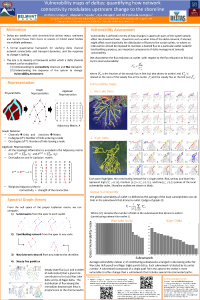CSDMS 2015 annual meeting poster AnthonyLongjas
Vulnerability maps of deltas: quantifying how network connectivity modulates upstream change to the shoreline
Alejandro Tejedor, University of Minnesota, Minnesota, Pennsylvania, United States.
Ilya Zaliapin, University of Nevada, Nevada, United States.
Efi Foufoula-Georgiou, University of Minnesota, Minnesota, United States.
Abstract:
The complex bifurcation and merging structure (called connectivity) of delta channel networks and the partitioning of fluxes at every junction determine the spatial flux distribution on the deltaic surface from the apex to the shoreline. Changes in any upstream part of the network will propagate downstream, and depending on the location of this change and the network connectivity, a particular perturbation will be attenuated to a different degree on its way to the shoreline. It is of interest to have a computationally efficient framework by which every channel in the delta network can be assigned a “vulnerability index” according to its potential to mitigate the propagation of the local change (e.g., a reduction of flux) to the shoreline. Here we present a framework for performing such an analysis by conceptualizing the network as a directed graph and using spectral graph theory to compute steady-state fluxes. We use the developed framework to construct vulnerability maps that quantify the relative change of sediment and water delivery to the shoreline outlets in response to possible perturbations in hundreds of upstream links. This enables us to evaluate which links (hotspots) and what management scenarios would most influence flux delivery to the outlets, paving the way for systematically examining how local or spatially distributed delta interventions can be studied within a systems approach for delta sustainability.
* Please acknowledge the original contributors when you are using this material. If there are any copyright issues, please let us know and we will respond as soon as possible.

